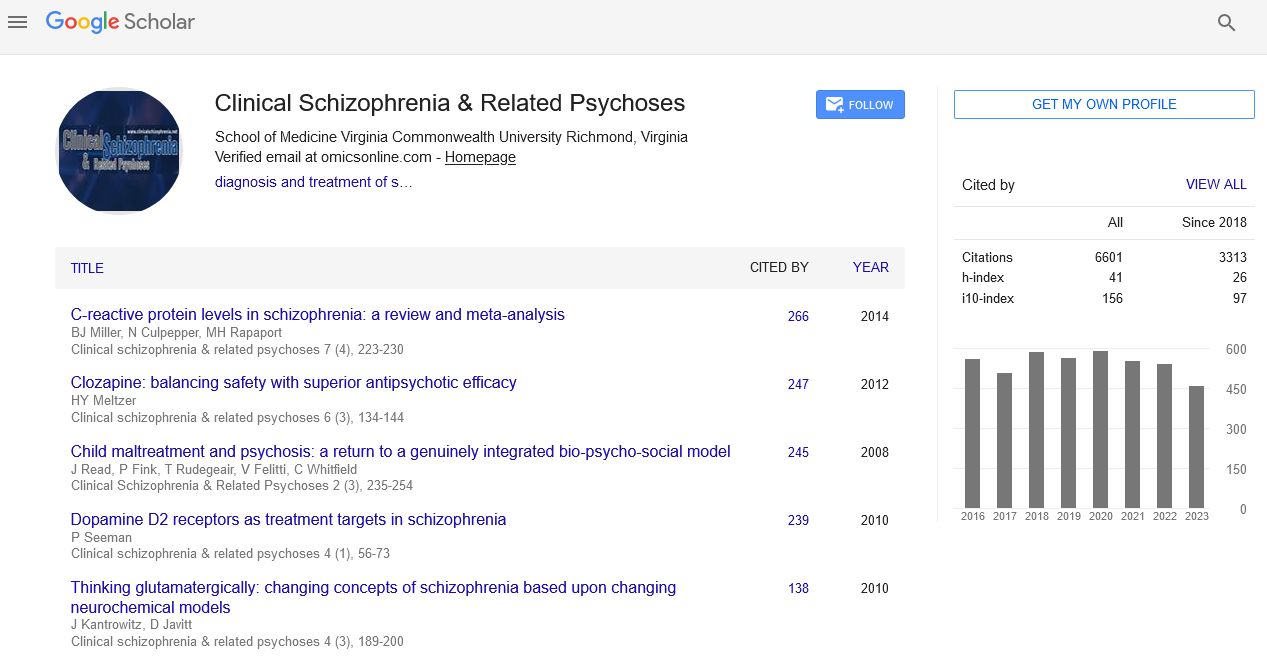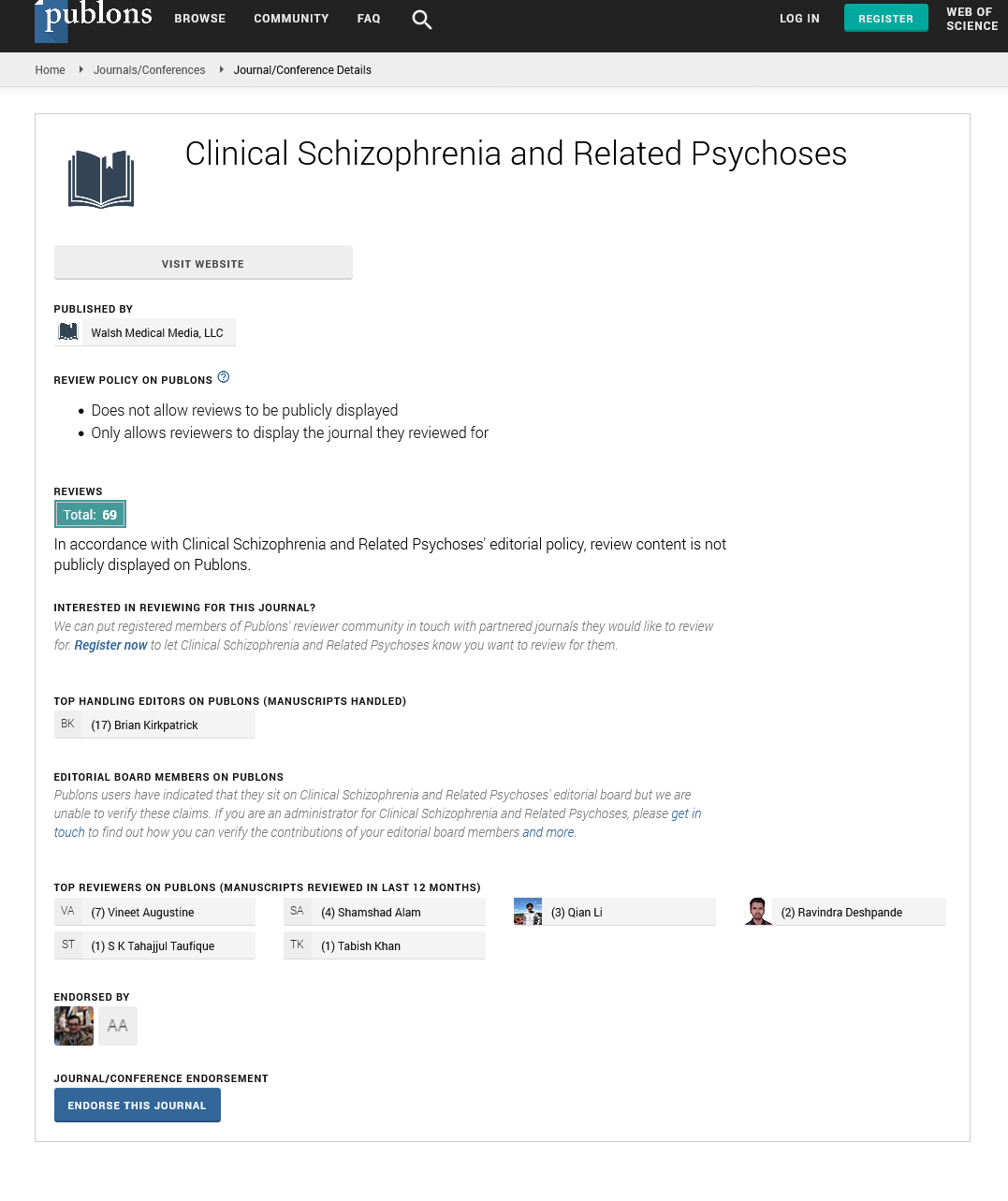Research Article - Clinical Schizophrenia & Related Psychoses ( 2022) Volume 0, Issue 0
Pattern of psychiatric morbidity among CRD patients: Cross sectional South Indian study.
Received: 15-Oct-2022, Manuscript No. CSRP-22-77460; Accepted Date: Oct 27, 2022 ; Editor assigned: 15-Oct-2022, Pre QC No. CSRP- 22-77460 (PQ); Reviewed: 17-Oct-2022, QC No. CSRP-22-77460(Q); Revised: 25-Oct-2022, Manuscript No. CSRP-22-77460 (R); Published: 31-Oct-2022, DOI: 10.3371/CSRP.MMWY.100128
Abstract
Aims and objectives: Psychiatric morbidities significantly contribute to the functional impairment in patients with chronic respiratory disease [CRD]. The burden of psychiatric morbidities seems to vary with geographical areas and other factors. This study was carried out with the aim to find out the psychiatric morbidities in stable chronic respiratory disease patients in North Karnataka region, India so that a proper assessment of mental health and comprehensive management can be planned.
Methodology: Cross sectional observational study design was used. 160 patients diagnosed with CRD attending respiratory outpatient department (OPD) were included. Structured proforma containing socio-demographic details and text revision of fourth edition of diagnostic and statistical manual disorders (DSM IV TR) diagnostic criteria for diagnosis were used for psychiatric evaluation. Hamilton Depression Rating Scale (HAMD), Hamilton Anxiety Rating Scale [HAMA] and Brief Psychiatric Rating Scale (BPRS), were used to assess the severity of the respective conditions.
Results: Psychiatric evaluation of CRD patients revealed that 50% developed psychiatric morbidity. Majority were males, aged above 50 years, married and from rural background. 78 (48.75%) cases were chronic obstructive pulmonary disease (COPD) followed by asthma 34 (21.25%) cases. 37.5% were tobacco users. 74 (46%) cases fulfilled criteria for major depression disorder and 6 (4%) had features of anxiety disorder. In 80 (50%) cases no psychiatric morbidity was found.
Conclusion:Major depression disorder is the most common psychiatric morbidity followed by anxiety disorders. Careful observation for psychiatric morbidities among chronic respiratory disease patients may help in early identification and better holistic management.
Keywords
CRD, tobacco, anxiety, depression, scale
Introduction
Psychiatric morbidities significantly contribute to the functional impairment in patients with chronic respiratory disease (CRD) like COPD, asthma, bronchiectasis etc and treatment of these serves to improve both the psychiatric and pulmonary status [1]. World Health Organization defines Chronic respiratory diseases as group of chronic diseases affecting the airways and other structures of lungs. Global Initiative for chronic obstructive lung disease defined COPD as FEV1/FVC <0.70 [2]. Anxiety and depression are the commonest psychiatric diagnoses in COPD patients [3]. The estimates are showing that the problem of COPD and psychiatric morbidities are more prevalence and coexistent in South East Asia region and particularly in India [4].
The prevalence of mental and physical co-morbidities though thought to be high, is not clearly known in India, as estimates of psychiatric disorder among patients with non-communicable diseases have predominantly come from studies conducted in neighbour countries [5]. The burden of psychiatric morbidities associated with chronic respiratory diseases vary with geographical areas, cultural background, habits like smoking, socio-economic conditions, availability of healthcare facilities, etc. Varying prevalence rates have been reported from different parts of the world [6,7]. This study was undertaken to estimate the burden of Mental Health Disorders [MHD] associated with CRD among stable patients in North Karnataka region, India. The study would give better insight in management of patients as a whole.
Material and Methods
A Cross sectional hospital-based observational study was conducted in order achieves the study objectives. The study was conducted after obtaining informed written consent/ assent form from parents for the subjects aged less than 18 years. This study was approved by the institutional ethics committee. Sample size estimation was conducted using openepi software version 2.3.1 using formula 4pq/l2. Based on the study conducted by De S [8]. the prevalence of depression in COPD was 72%. Considering 10 percent relative precision, and 95% confidence limit and design effect of 1, sample size estimated was 146. Considered 10 percent for sample loss, the sample size was decided to be 160. Patients suffering from chronic respiratory diseases attending Respiratory Medicine OPD of a tertiary care medical college hospital in North Karnataka India, over a period of six months (Nov 2017 to April 2018) were included in the study. All confirmed asthma, bronchiectasis, COPD and post tuberculosis adult patients were included. COPD is a common, preventable and Treatable Disease that is characterized by persistent respiratory symptoms and airflow limitation that is due to airway and/or alveolar abnormalities usually caused by significant exposure to noxious particles or gases. Global Initiative for chronic obstructive lung disease defined COPD as FEV1/FVC <0.70.2 Patients with acute exacerbations of respiratory symptoms, patients with co-morbid medical conditions like congestive heart failure, coronary artery disease, uncontrolled diabetes mellitus, uncontrolled hypertension, HIV and active tuberculosis on treatment., also those having psychiatric illnesses before the onset of chronic respiratory diseases were excluded from the study.
All patients were first examined by consultant Pulmonologist to confirm the chronic respiratory diseases. Socio-demographic data, history, physical and mental status examination done using structured proforma. Later each patient was evaluated by consultant psychiatrist and diagnosed based on DSM IV-TR, severity was assessed based on Hamilton Depression Rating Scale (HAM-D), Hamilton Anxiety Rating Scale (HAM-A) and Brief Psychiatric Rating Scale (BPRS) . Socioeconomic status assessed using modified BG Prasad classification.
HAM-D is the most widely used clinician-rated scale for the assessment of depression severity in patients who are diagnosed with a depressive disorder [9]. It consists of 17 or 21 items scored between 0 and 4 points [10,11] The first 17 measures the severity of depression and the extra four items measures non-severe factors related to depression such as obsessional and compulsive symptoms. A 17-item scale shows 0–7 score as normal, 8–13 suggests mild depression, 14–18 suggests moderate depression, 19–22 severe depression, and 23 above score are indicative of very severe depression. We used 17-item scale for our study.
The HAMA scale is most widely used to measure the severity of perceived anxiety symptoms. [12] It consists of 14 symptom-defined elements mainly focused on psychologic and somatic symptoms with great belief on patient's subjective report. The score 0–13 indicates normal level of anxiety, 14–17 as mild anxiety, 18–24 as moderate, and 25 or more indicates severe anxiety.
The BPRS is a clinician-rated scale which is one of the widely-used instruments enabling the clinician to quickly gather information about the possible presence and severity of various psychiatric symptoms [13]. Eighteen items were assessed that are grouped into 5 domains: anxiety/ depression, anergia, thought disorders, activation and hostility/mistrust. Each of the respective items was rated on a seven-point scale ranging from 1 (not present) to 7 (extremely severe).
Results were tabulated and analysed by entering data in Microsoft excel, later analysed using SPSS software version 19. Proportions were used for representing qualitative data. Chi square test was applied for association. P<0.05 was considered as statistically significant.
Results
About 160 subjects were included in the study where 56.9% of study subjects were males and 43.1% were females. More than 50% were aged above 50 years of age. Majority belonged to Hindu religion (94.4%), were married 140 (87.5%) and residents of rural areas (71.9%). Most of the subjects were illiterate (38.8%). Around 13.1% were graduates, 24.4% educated up to primary standard, 20.6% up to high school level while 3.1% were educated up to intermediate standard. Farmers (41.9%) and unskilled workers (26.3%) formed the majority of the population. Being from rural background (71.9%), majority of the population lived in joint families (63.8%) with majority belonged to upper middle class. It was found that 41.9% of the population had illness of duration less than 1 year and majority (58.1%) had duration of illness more than 1 year. There was a statistically significant difference in sex, socioeconomic status and religion with the existence of psychiatric morbidity (p<0.05). But other socio demographic variables were not significantly different (Table 1 and 2).
| VARIABLES | (N=160) | PSYCHIATRIC MORBIDITY (%) | P value, Sig | |
|---|---|---|---|---|
| SEX | MALE | 91 | 36.30% | 0.002, Sig |
| FEMALE | 69 | 60.90% | ||
| AGE | 15-25 | 8 | 37.50% | 0.159, NS |
| 26-35 | 18 | 50.00% | ||
| 36-45 | 28 | 67.90% | ||
| 46-55 | 61 | 42.60% | ||
| 55+ | 45 | 40.00% | ||
| EDUCATION | Illiterate | 62 | 54.80% | 0.423, NS |
| Primary | 39 | 43.60% | ||
| Secondary | 33 | 45.50% | ||
| Intermediate | 5 | 20.00% | ||
| Graduation | 21 | 38.10% | ||
| MARITAL STATUS | Single | 7 | 71.40% | 0.298, NS |
| Married | 140 | 45.00% | ||
| Separated | 1 | 0 | ||
| Divorced | 1 | 0 | ||
| Others | 11 | 63.60% | ||
| OCCUPATION | Skilled | 118 | 48.30% | 0.543, NS |
| Unskilled | 42 | 42.86% | ||
| SOCIO ECONOMIC STATUS | Class I | 54 | 44.44% | 0.19, NS |
| Class II | 66 | 62.50% | ||
| Class III | 14 | 50% | ||
| Class IV | 8 | 42.42% | ||
| Class V | 18 | 59.26% | ||
| TYPE OF FAMILY | Nuclear | 56 | 58.90% | 0.042, Sig |
| Extended | 2 | 0 | ||
| Joint | 102 | 42.16% | ||
| SUBSTANCE USE | Present | 60 | 48.30% | 0.775, NS |
| Absent | 100 | 46.00% | ||
| RESIDENCE | Urban | 29 | 44.80% | 0.682, NS |
| Semi-urban | 16 | 37.50% | ||
| Rural | 115 | 48.70% | ||
| RELIGION | Hindu | 151 | 52.98% | 0.027, Sig |
| Muslim | 9 | 0 | ||
| Christian | NIL | |||
| DURATION OF RESPIRATORY ILLNESS IN YEARS | <1 | 67 | 43.30% | 0.908, NS |
| 3-Jan | 34 | 52.90% | ||
| 03 – 06 | 32 | 50.00% | ||
| 06 – 10 | 16 | 50.00% | ||
| 10 – 15 | 3 | 33.37% | ||
| >15 | 8 | 37.50% | ||
| Respiratory disease | MDD | Anxiety | |
|---|---|---|---|
| N=160 | |||
| COPD | 76 | 46.20% | 6.40% |
| TB | 29 | 75.90% | 0 |
| ASTHMA | 33 | 35.30% | 2.90% |
| BRONCHITIS | 19 | 21.10% | 0 |
Most common diagnosis found in our population was COPD (48.8%) followed by asthma (21.3%). Tobacco chewing habits were found in 51.7% of the study sample. Mild to severe depression seen more among females whereas very severe depression seen among male population.
It was found that there was an association found between socio economic statuses of anxiety, which was found to be statistically significant. (p<0.05*).
Among 74 (46%) patients who suffered from major depressive disorder, thirty three (20.6%) had mild depression, 23 (14.38%) had moderate depression, six (3.75%) had severe depression, and twelve (7.5%) had very severe depression.
In anxiety disorder group, out of six (four percent) cases, three (1.88%) cases had mild anxiety, two (1.25%) cases had moderate anxiety, and one (0.63%) had severe anxiety.
Major depression disorder was found in 75.9% cases of posttuberculosis followed by 46.2% of patients of COPD and 35.3% in patients of Asthma. Whereas anxiety disorder was most commonly associated with COPD in 6.4% cases followed by asthma in 2.9% cases.
Discussion
This study was mainly undertaken to study the psychiatric morbidity in chronic respiratory diseases.
In our study, majority of males (56.9%) were of age range above 50 years and around 55% education up to secondary standard. A recent study conducted by Chinwong D et al noted that males are up to 15 – 20 times more likely to smoke than females in developing countries like India, and smoking is the most widely studied risk factor for the development of COPD [14]. A study conducted by Mehta J.R. et al noted that COPD is more prevalent among males with a median male-to-female ratio of 1.6:1 [15].
Majority of study subjects were aged above 50 years of age and it is well known fact that CRD are more common among the elderly population. Educational level among the study subjects was low, as nearly 87% were either illiterate or studied up to secondary standard level and most of them belonged to upper middle-class income group. As nearly half of the subjects had respiratory illnesses of few years duration and many had psychiatric co-morbidities, suggesting the need to start screening for them early.
In this study population, COPD (48.75%) was the commonest respiratory condition, followed by asthma [21.3%]. Tobacco use was found in 37.5% among which 51.67% of the study sample had psychiatric morbidity. As per Pauwels RA et al cigarette smoking has long been recognized as the primary cause of COPD in developed countries, and Ouellette DR et al. noted individuals with psychiatric co-morbidities are twice as likely to be cigarette smokers relative to those without psychiatric co morbidities, suggesting that psychiatric morbidity could precede the development of COPD [16].
COPD is one of the commonest CRD and are predisposed to common psychiatric morbidities. Risk factors for the development of cognitive impairment in COPD may also be associated with chronic hypoxia– hypercapnia [17]. Primary care physicians tend to fail to diagnose depression in more than half of depressed patients, which indicates a critical need to improve both the recognition and treatment of psychological distress among COPD patients. [6]
Several risk factors have been attributed for the development of depression and anxiety important ones being chronic and progressive nature of COPD which is characterized by frequent episodes of acute exacerbations necessitating hospital admissions, may cause anxiety, hopelessness, helplessness, and depressed mood. Finally, the fact that COPD is typically diagnosed later in life, when patients are more likely to experience age-related losses [retirement, death of loved ones, diminishing social networks], may increase feelings of loneliness and may also trigger symptoms of depression and anxiety [18].
Anxiety and depression were commonest psychiatric co-morbidities in this study. Depression was found 46.15% of patients of COPD and 35.29% in patients of Asthma. Whereas anxiety was most commonly associated with COPD in 6.41% of cases followed by Asthma. The exact causes of depression and anxiety in patients with COPD were not clearly known. However, they are likely to be due to a complex interaction between physiological, behavioral, and psychosocial factors [19].
Available evidence suggests that worse outcomes in COPD patients with psychiatric co-morbidity may be related to poorer health behaviours and worse disease self-management. Depression and anxiety are associated with feelings of helplessness, withdrawal, hopelessness, and fear, which tend to lower patients’ ability to self-manage their disease. COPD patients with depression have been shown to have worse adherence to medical treatment and are more likely to be persistent smokers [6, 20].
Among the several treatment options available for COPD patients suffering from anxiety and/or depression, psychotherapy, pharmacotherapy, and exercise within the context of a comprehensive pulmonary rehabilitation program are considered important. Although mixed, the literature indicates that CBT is likely to be useful in reducing anxiety and depression among COPD patients [6]. Exercise treatment as part of a comprehensive pulmonary rehabilitation program [individualized exercise and education] has also demonstrated reductions in levels of depressive and anxiety symptoms among COPD patients when compared with usual care [21].
The main limitations of this study include, this was a single hospitalbased cross-sectional study. Hence, prevalence rates reported are therefore likely to underestimate true prevalence in the community. Also being a cross-sectional study, cause-effect relationship could not be established and it is recommended to conduct further populationbased, multicentre cohort studies for establishing the same.
Conclusion
This study design revealed that considerable numbers of patients were suffering from COPD and majority were males without family history of psychiatric illness. Smoking and low educational level could be factors influencing the disease status and its management in this population. Depression is the commonest psychiatric morbidity followed by anxiety. These findings suggest that routine screening for psychiatric morbidities among CRD patients help in early identification. Treatment of such psychiatric co-morbidities among chronic respiratory diseases is imperative for health and wellbeing.
Source of Support
Nil.
Declaration of Interest
None.
References
- World Health Organization. "Management of physical health conditions in adults with severe mental disorders
- Lessiani, Gianfranco, et al. "Prevalence of deep vein thrombosis in patients affected by exacerbation of mild to moderate COPD at stage I-II of GOLD classification." Archives of Medical Science 4.1 (2008): 62-65.
- Kunik, Mark E., et al. "Surprisingly high prevalence of anxiety and depression in chronic breathing disorders." Chest 127.4 (2005): 1205-1211.
- Google scholar
- Koly, Kamrun Nahar, et al. "Anxiety and Insomnia Among Urban Slum Dwellers in Bangladesh: The Role of COVID-19 and Its Associated Factors." Frontiers in Psychiatry 12 (2021).
- Ouellette, Daniel R., and Kim L. Lavoie. "Recognition, diagnosis, and treatment of cognitive and psychiatric disorders in patients with COPD." International journal of chronic obstructive pulmonary disease 12 (2017): 639.
- Van Ede, L., C. J. Yzermans, and H. J. Brouwer. "Prevalence of depression in patients with chronic obstructive pulmonary disease: a systematic review." Thorax 54.8 (1999): 688-692.
- De, Sajal. "Prevalence of depression in stable chronic obstructive pulmonary disease." Indian Journal of Chest Diseases and Allied Sciences 53.1 (2011): 35.
- Bech, Per. "Fifty years with the Hamilton scales for anxiety and depression." Psychotherapy and Psychosomatics 78.4 (2009): 202-211.
- Hamilton, Max. "A rating scale for depression." Journal of neurology, neurosurgery, and psychiatry 23.1 (1960): 56.
- Bagby, R. Michael, et al. "The Hamilton Depression Rating Scale: has the gold standard become a lead weight?." American Journal of Psychiatry 161.12 (2004): 2163-2177.
- Hamilton, M. A. X. "The assessment of anxiety states by rating." British journal of medical psychology (1959).
- Overall, John E., and Donald R. Gorham. "The brief psychiatric rating scale." Psychological reports 10.3 (1962): 799-812.
- Dodd, J. W., S. V. Getov, and Paul W. Jones. "Cognitive function in COPD." European Respiratory Journal 35.4 (2010): 913-922..
- Wiese, Bonnie S. "Geriatric depression: the use of antidepressants in the elderly." BC Med J 53.7 (2011): 341-347.
[Google scholar] [Cross ref]
- Pauwels, Romain A., and Klaus F. Rabe. "Burden and clinical features of chronic obstructive pulmonary disease (COPD)." The Lancet 364.9434 (2004): 613-620.
- Chinwong, Dujrudee, et al. "A comparison of gender differences in smoking behaviors, intention to quit, and nicotine dependence among Thai university students." Journal of addiction 2018 (2018).
- Mehta, Jilan Rameshchandra, et al. "Association of psychiatric co-morbidities and quality of life with severity of chronic obstructive pulmonary disease." East Asian Archives of Psychiatry 24.4 (2014): 148-155.
[Google scholar] [Cross ref]
- Yohannes, A. M., and G. S. Alexopoulos. "Pharmacological treatment of depression in older patients with chronic obstructive pulmonary disease: impact on the course of the disease and health outcomes." Drugs & aging 31.7 (2014): 483-492..
[Google scholar] [Cross ref]
- Teixeira, Paulo Josè Zimermann, et al. "Post-traumatic stress symptoms and exacerbations in COPD patients." COPD: Journal of Chronic Obstructive Pulmonary Disease 12.1 (2015): 90-95.
- Marquis, Karine, et al. "The metabolic syndrome in patients with chronic obstructive pulmonary disease." Journal of Cardiopulmonary Rehabilitation and Prevention 25.4 (2005): 226-232.
[Google scholar] [Cross ref]
Citation: Mara B, Prabhakar H, Kumar S, Vinod A, Ravi PB, et al. "Pattern of psychiatric morbidity among CRD patients: Cross sectional South Indian study". Clin Schizophr Relat Psychoses 16S2 (2022) doi: 10.3371/CSRP.MMWY.100128
Copyright: © 2022 Vinod. A, et al. This is an open-access article distributed under the terms of the Creative Commons Attribution License, which permits unrestricted use, distribution, and reproduction in any medium, provided the original author and source are credited. This is an open access article distributed under the terms of the Creative Commons Attribution License, which permits unrestricted use, distribution, and reproduction in any medium, provided the original work is properly cited.






